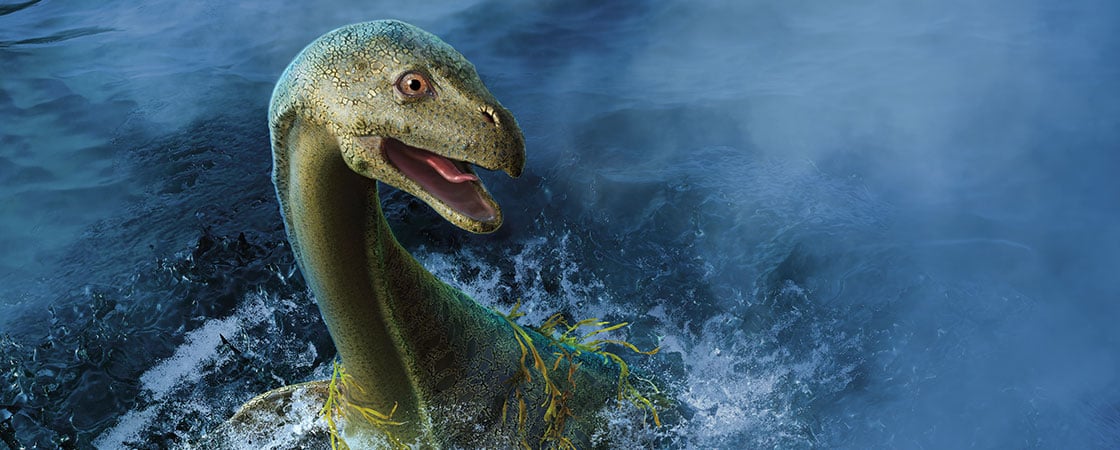Jim McMahon/Mapman®
On a cool afternoon in 1933, Aldie and John Mackay were driving along the shores of Scotland’s largest lake. The Loch Ness was usually murky. (Loch is the Scottish term for lake; pronounced “lock.”) On this day, its waters sparkled in the sunshine.
Then Aldie saw something she would never forget. The water rippled. A giant creature seemed to rise out of the loch. It appeared to be black, with a humped back.
Aldie grabbed her husband’s arm. She screamed, “Stop! The beast!” John stopped the car. The creature seemed to “roll and plunge” in the water. For several minutes, the couple stared at the lake. Finally, the creature disappeared.
News spread about what the Mackays had seen. Some people rolled their eyes and laughed. But many others were fascinated. There had always been something mysterious about the Loch Ness, something spooky.
The story was believed by many people who lived near the lake. In fact, it was a local legend. For hundreds of years, people had whispered about a creature living in the loch. The stories told of a huge, scary beast. Many stayed away from the woods around the lake because of these stories.
Over the next few weeks, rumors spread about a long-necked creature.
“It was horrible,” reported a schoolteacher. “It had a head like a cobra.”
“It was as big as an elephant,” said a local farmer.
“My heart stopped,” described a visitor. “It looked right at me.”
Was there really a monster living in the lake?
It was a cool afternoon in 1933. Aldie and John Mackay were driving next to Scotland’s largest lake. The Loch Ness was usually murky. (Loch is the Scottish term for lake; it’s pronounced “lock.”) On this day, its water sparkled in the sunshine.
Then Aldie saw something she would never forget. The water rippled. A giant creature seemed to rise out of the loch. It looked black, with a humped back. Aldie grabbed her husband’s arm. She screamed, “Stop! The beast!” John stopped the car. The creature seemed to “roll and plunge.” The couple stared at the lake for a few minutes. Finally, the creature disappeared.
News spread about what the Mackays had seen. Some people rolled their eyes and laughed. But many others were fascinated. The Loch Ness had always seemed mysterious. It was a spooky place.
Many people who lived near the lake believed the story. It was a local legend. The legend told of a lake creature. People had whispered the stories for hundreds of years. They said the creature was a huge, scary beast. Many stayed away from the lake because of these stories.
Rumors spread about a long-necked creature.
“It was horrible,” said a schoolteacher. “It had a head like a cobra.”
“It was as big as an elephant,” said a local farmer.
“My heart stopped,” described a visitor. “It looked right at me.”
Was there really a monster living in the lake?
It was a cool afternoon in 1933. Aldie and John Mackay were driving next to Scotland’s largest lake. The Loch Ness was usually murky. (Loch is the Scottish term for lake; it’s pronounced “lock.”) On this day, its water sparkled in the sunshine.
Then Aldie saw something she would never forget. The water rippled. A giant creature seemed to rise out of the loch. It looked black, with a humped back.
Aldie grabbed her husband’s arm. She screamed, “Stop! The beast!” John stopped the car. The creature seemed to “roll and plunge.” The couple stared at the lake for a few minutes. Finally, the creature disappeared.
News spread about what the Mackays had seen. Some people rolled their eyes and laughed. But many others were fascinated. The Loch Ness had always seemed mysterious. It was a spooky place.
Many people who lived near the lake believed the story. It was a local legend. The legend told of a lake creature. People had whispered the stories for hundreds of years. They said the creature was a huge, scary beast. Many stayed away from the lake because of these stories.
Rumors spread about a long-necked creature.
“It was horrible,” said a schoolteacher. “It had a head like a cobra.”
“It was as big as an elephant,” said a local farmer.
“My heart stopped,” described a visitor. “It looked right at me.”
Was there really a monster living in the lake?

